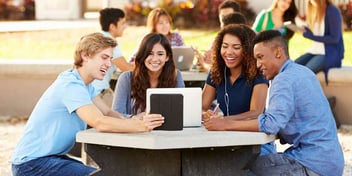How Science Students Can Collaborate in a Digital World
By Kari Clarkson
This blog appeared on D2L.com
At D2L Fusion 2022, we spoke to Jen Alexander about the challenges students face when learning science in a digital environment and the ways she tackles these challenges at VHS Learning.
Jen Alexander is a curriculum coordinator at VHS Learning for the science and engineering program. Alexander is busy in her role, supporting both teachers and learning through a variety of responsibilities. She revises and creates science and engineering courses, manages the day-to-day support of teachers in and curriculum of science courses, and is a faculty advisor for advanced placement teachers of science courses.
At D2L Fusion 2022 in Boston, Massachusetts, we spoke to Alexander about the challenges students face when learning science in a digital environment and the ways she tackles these challenges at VHS Learning. Here’s what she had to say:
Challenges Faced by K-12 Learners in a Digital Environment
One of the unique challenges students face in a digital environment is time management. They often struggle with managing how to fit an asynchronous self-paced course into their lives. It’s easy for them to put learning off because they don’t have a teacher catching them in the hallway saying, “Hey, you didn’t submit your work.”
Another big one is collaboration. I feel like it’s important, especially for high school students, to have opportunities to discuss things with their peers, from English to social studies, to science and math.
A challenge for teachers is to pick up on misconceptions that students might have. It’s not quite as easy. You can’t see that confused look on a student’s face, necessarily, through the computer screen.
Finally, something I’m super passionate about is I think it’s trickier to provide a rigorous hands-on science course through a digital platform.
Challenges and Solutions for Science Students Learning Online
If we’re thinking of science courses and the challenges that students might face in the digital world, collaboration is super important and is something that may present as a challenge.
If you think about scientists in the real world, they’re not working in a lab in isolation. They’re discussing their lab techniques, their data, supporting each other and making sure that the data’s reliable. They have multiple trials going on.
That presents a unique challenge in the digital world because you’ve got to find a way for students to have those discussions and share their data so that they’re able to analyze larger data sets.
Our courses are very carefully designed to provide opportunities for students to complete their labs, have discussions and share their data. For example, one lab might span three weeks. They might be writing a lab proposal one week to give the teacher time to provide the students some feedback. The next week, we give them a full week to perform the lab. We want to make sure that they’re taking their time and finding the proper and safe space to complete the lab. Then they might share their data with their class through these wiki pages that we use, where we can have data tables filled in by everybody in the class. Then we might have them looking at the full data set in a discussion and talking about the data.
We also offer opportunities for them to share their experimental designs. If it happens to be an inquiry-based lab, students are given a question like “Using the materials in your lab kit, answer this question.”
We want them to share their experimental design with their peers so they can get some feedback from their peers and learn from each other. Doing this in the discussions area of D2L Brightspace also provides the opportunity for the teacher to see if there’s misconceptions happening between the students.
Using Peer Review to Boost Collaboration in Science Classes
Peer review plays a role in improving efficacy in science courses in the digital environment because it allows students to have those collaborative opportunities that they might be missing from a face-to-face classroom.
If you think about doing a lab in a face-to-face classroom, you’re thinking about students working in a group, discussing their experiment together, coming up with a class set of data and then being able to have conversations about what data looks right: Are there any outliers to this data? What makes sense? The teacher is able to correct misconceptions on the spot in the classroom.
In the digital world, that’s a little tricky because everybody might be doing the lab on a different day at a different time. Providing the opportunity for students to use the discussion board in Brightspace allows them to share their work and have those collaborative opportunities. We ask our students to share their experiments and talk about their design process, and then we ask their peers to come and provide some feedback and look for holes or misconceptions.
It also gives the teacher the opportunity, since they can oversee the discussion area, to jump in and correct any misconceptions or to encourage students who might be having a hard time. It also provides the opportunity for students to analyze larger data sets, which is super important in science. You can’t just make a statement about a truth without multiple data sets.
Advice to Improve Outcomes in a Digital Course
My advice to any organization looking to improve outcomes in a digital world would be to first provide the opportunity for students to get a lab kit. We provide our students with carefully designed lab materials. They all get the same materials to work with so there’s no question, especially, for example, in an AP chemistry course, where a student is just going out and grabbing random samples of chemicals and mixing them together. The instructions are very clear on the step-by-step guidance in many of the labs for what they need to do, and we only focus on those materials. Providing those materials is important for students and something that I think sets VHS Learning apart from some other organizations, because we do have the hands-on component. We don’t just rely on virtual labs.
Teacher training is important. You have to put on a slightly different hat when you’re a teacher in the virtual world. Our teachers are trained through an Online Teaching Methodologies course that is designed by VHS Learning, and they have to complete that course before they can teach for us.
After they take that course and they’re in their first semester, they’re also mentored by another faculty member who’s been at VHS Learning for a little while or one of our curriculum coordinators or instructional coordinators, so there’s a lot of support for all of our teachers.
This interview has been edited and condensed for clarity.
Kari is a Content Marketing Specialist at D2L who focuses on the world of higher education. She enjoys using her research, reporting, writing and multimedia skills to tell impactful stories.


